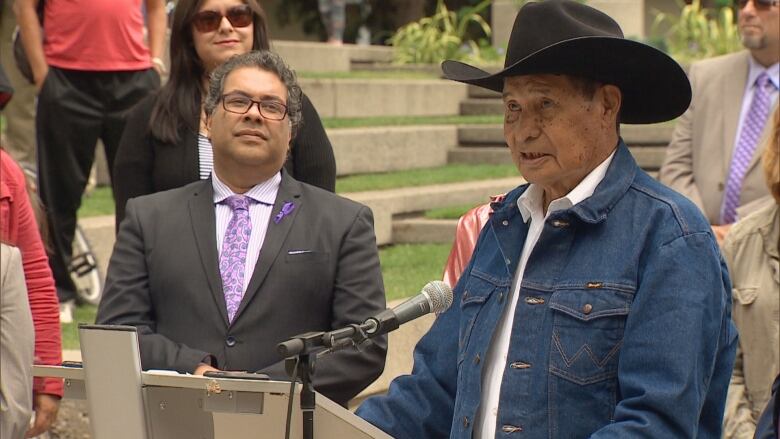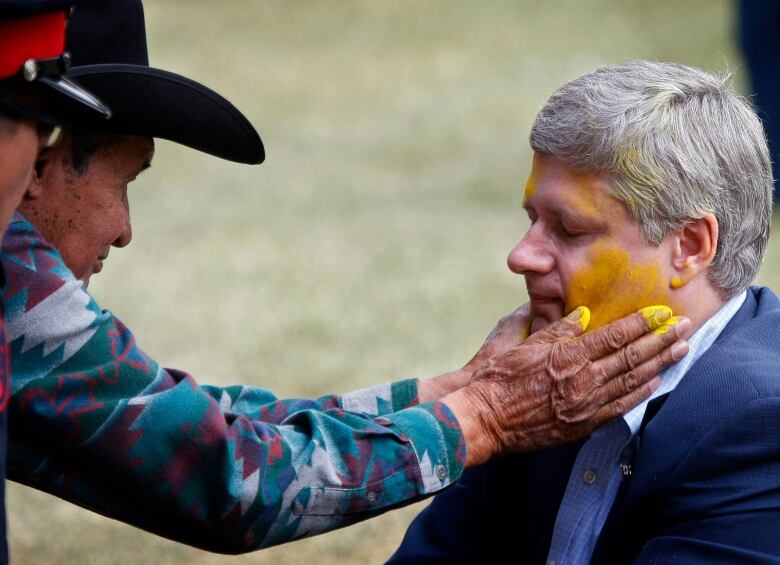Blackfoot elder remembered as 'truly a cowboy,' Indigenous advocate
From rodeo rider and roughneck, Pete Standing Alone grew into beloved, respected Blood Tribe leader

Pete Standing Alone bred horses, competed in the rodeo, featured in more than a dozen films and painted the face of Prime Minister Stephen Harper.
As a young oil roughneck and cowboy, he felt alienated from his Indigenous identity but over the years, he became one of the great advocates for Blackfoot people.
Standing Alone died at age 90 on Nov. 27. His funeral is Saturday at Kainai High School in southern Alberta.
"He will be remembered as a cowboy, as an elder, as an astute businessman,as a role model. You know, he worked hard all his life," said longtime friendLeonardBastienofPiikaniFirst Nation.
Standing Alone was a member of Blood (Kainai) First Nation. He dedicated his life tohelping the people in his home community.

Standing Alone was typically good natured in his determination to accomplish a goal, though his stubbornness was legendary.
A few weeks before his death, he snuck out ofhis supervisedcare home,Bastiensaid. As he wasn't allowed to drive, he shouldn't have been able to get very far.
"He was nowhere to be found. There he was, out driving out on the prairies, checking on his cattle," Bastiensaid with a chuckle.
Standing Alone loved the grasslands, the nature and its residents. As a young man, he lived the cowboy life and his work earned him much respect.

As a rodeo rider, he learned to make saddles by hand, including one he gave to Prince Charles. He also bred and trained bucking stock horses.
Bastienfirst met Standing Alone in the early1960sat school. Standing Alone was showing a film he starred in, Circle of the Sun. It featured the KainaiNation's sun dance.
AsBastien'sresidential school had closed only a year earlier, that memory remains clear in his mind.
"To say the least I had the greatest respect for Pete," he said. "He was my greatest support in the work that I do, in supporting our ways of life, Blackfoot worldview."
In 1977, Prince Charles was made an honorary chief of KainaiNation, and the National Film Board made a film about it, including Standing Alone's insight.
NFBlater produced a film on his life, called,Standing Alone.Itsketched the first 25 years of his life from being aoil-rig roughneck, cowboy androdeo rider to learning to bea proud Indigenous man on a mission to preserve that cultural and spiritual understanding.
The film won awards, and in 2010, the late filmmaker and Blood Tribe elder NarcisseBlood followed up with the film, Round Up. At age 81, Standing Alone discussedhis work to repair spiritual and cultural destruction caused by residential schools, having moved from being a culturally alienated young man to an elder.

Bastien said one of his skills was bridging the gap between people and different societies, which he did bysharing his knowledge with universities and governments and fostering understanding. Most importantly, Bastien said, he helped do so with new generations of Blackfoot people.
As an elder and band councillor, he painted Stephen Harper's face with sacred yellow ochre and invested him into the Kainaichiefmanship. His granddaughter, Marcia Black Water, said he considered carefully whether or not he should participatein the then-controversial act.
"I know there was a lot of people in our community that didn't agree with it, and maybe right across Canada," granddaughterMarcia Black Water said. "For my grandpa, he thought that was an opportunity, not so much for us as Native people, but for Harper, to really truly give him an opportunity to add to his leadership and the promises that he makes."
StandingAlone was a resource for Blackfoot cultural, history and language, his obituary notes, and led ceremonial activities. He also waskey to developing the Blood Tribe Agricultural Project, a massive irrigation program that produced high calibre hay for export, bringing a health centre to the community and naming theNiitsitapiLearning Centre.
'Truly a cowboy'
He also advisedmuseums and archives on cultural consideration, as well asthe University ofLethbridge, which granted him an honorary lawdegree for his role as a Blackfoot Knowledge Keeper,educator and role model.
Standing Alone also kept up his advocacy work late into his life despite a prostate cancer diagnosis eight years ago, Black Water said. In the end, his age caught up with him.
"My grandpa was truly a cowboy through and through. He worked hard from morning till night, and he had a hard time asking anyone for help," Black Water said. "He just had that strength of just a strong man and he persevered through just everything."
Standing Alone hadnine children and a step-daughter,31 grandchildren, 62 great grandchildren and threegreat great grand children. Also, he adopted several people through Blackfoot tradition, symbolizing a close friendship and connection, Black Water said.
The funeral on Saturday is open to the public.
- MORE ALBERTA NEWS |Calgary Flame's parents clock 13,000 kilometres to watch his games
- MORE ALBERTA NEWS |Cannabis businesses start up on Tsuut'ina First Nation
- Read more articles byCBC Calgary, like us onFacebookfor updates and subscribe to ourCBC Calgary newsletterfor the day's news at a glance
With files from theCalgary Eyeopener.












_(720p).jpg)


 OFFICIAL HD MUSIC VIDEO.jpg)
.jpg)



























































































